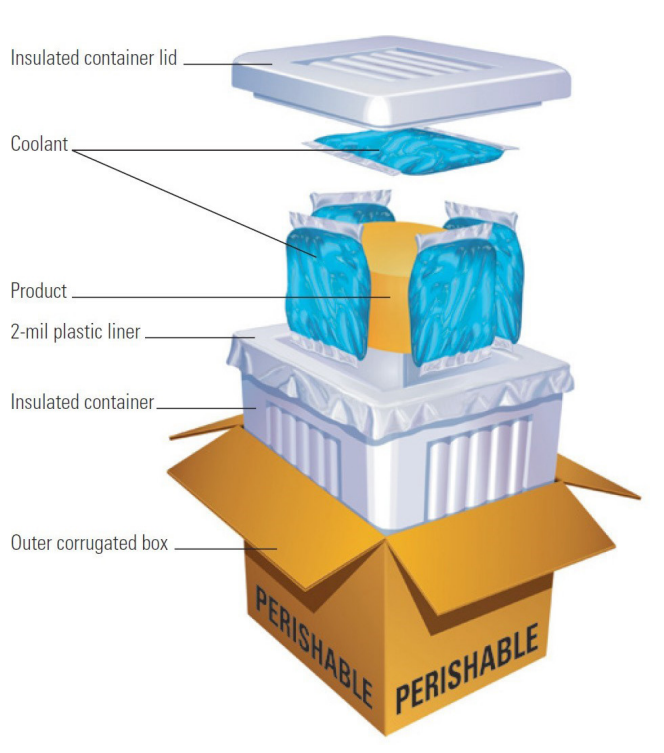Transfer of biomaterials between labs, buildings, and roadways is strictly regulated by various federal, state, and local agencies. Proper packaging is essential to ensure safe transport and to avoid sample loss and accidental release/exposure.
All laboratory personnel who transport or work with these materials are required to complete packaging and shipping training, plus other trainings defined by the nature of the material, such as Bloodborne Pathogens training.
Infectious materials meeting the definition of a Category A substance must be shipped by EHS. A Category A substance is a biological material in a form capable of causing permanent disability
or life-threatening or fatal disease in otherwise healthy humans or animals when
exposure to it occurs.
What I need to do...
- Label all biomaterials for transport with a description of the contents and contact information (e.g., name, phone number).
- Wrap primary liquid sample containers with sufficient absorbent material to soak up the entire volume of samples transported.
- Properly package all hazardous materials.
- If dry ice is used for temperature control, follow all safety requirements and regulations in order to minimize risk to personnel.
- DO NOT wear PPE during transport through public locations. Have PPE available in case of an accident.
- Notify the Department of Public Safety (801) 585-2677 for serious spills of a hazardous material (biological or chemical). EHS On-Call personnel will be notified.
Laboratory personnel may prepare biomaterials for transport if they are trained on use of correct packaging, safe transport of the materials, and have knowledge of emergency procedures in the event of an accident or spill. Training must be repeated every 2 years.
- Recombinant or synthetic nucleic acids, organisms, or micro-organisms
- Blood samples or other biological fluids and diagnostic specimens
- Cultures, suspensions, or lyophilized (freeze-dried) micro-organisms
- Fresh or preserved cells or tissues
- Viruses or subviral particles

- Place material in a tightly closed and secured leak- proof primary container.
- Seal the container with a tightly fitted cap and wrap closure with Parafilm™ or laboratory tape.
- Label the primary container to identify the material.
- Wrap each primary sample tube with enough absorbent material to absorb leakage (liquid sample).
- Place all primary samples in a sealable, leakproof secondary container labeled with a biohazard symbol.
- Suitable secondary containers can include a plastic specimen bag with a zip closure or plastic container with a fitted lid.
- Use a cart for movement between rooms or buildings.
- Wear PPE appropriate for transport within the laboratory (e.g., lab coat, gloves, and eye protection).
- For movement through public areas (e.g., between buildings or hallways), disinfect the outside of the secondary container and bring appropriate PPE for use at the laboratory destination or in case of a spill. DO NOT wear PPE in public areas.
- Wear the minimum PPE standard (full length pants or clothing that fully covers the legs and ankles, and closed, solid shoes) for transport through public areas. Bring or have hazard appropriate lab coats, protective eyewear, and gloves for use at the destination, if needed.
- If using a university vehicle, personnel transporting the materials must be authorized to use university vehicles and carry a valid driver’s license and have completed the University of Utah driver training program within the past 2 years.
- Proper containment and packaging must be used (see packaging requirements above).
- Personnel must be trained and authorized to handle and transport the materials. Contact biosafety@ehs.utah.edu for more information.
- If transported by private vehicle, the vehicle used must be for direct and exclusive transport of the sample to the destination (no other stops permitted).
- The packaging must be secured against shifting.
- Carry materials that can be used to clean up a spill (e.g. PPE, disinfectant, paper towels, biohazard waste bags).
- In the event of a spill resulting in exposure seek medical attention as soon as possible.
Infectious materials meeting the definition of a Category A are excluded from self-transport using a personal or university vehicle.
Yes. CAUTION: DO NOT transport biomaterials by public transport, shuttle, or taxi.

- Use cold packs or wet ice for temperature control during short-term transfers
- Place wet ice in a sealed plastic bag or leakproof container to prevent water leakage.
- Use special diagnostic shipping containers for frozen samples to maintain low temperature
without the use of dry ice. If dry ice must be used, personnel must follow Department
of Transportation (DOT) specifications for packaging in an insulated, gas- venting
container
- Place the dry ice outside of the secondary container inside an insulated cooler or similar gas-venting container.
- Do not place dry ice in a closed, non-venting container to avoid explosion or injury.
- Label the outside package with a “dry ice” label.

Contact biosafety@ehs.utah.edu for questions regarding transfer of biological materials Specialized training information is available at the Research Safety Training web page.
*Adapted from University of Southern California guidance
